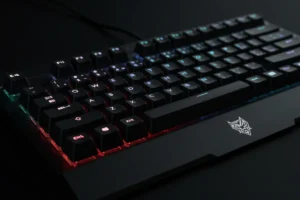I’ve been following keyboard trends for years, and when I first heard about Ghost Keyboards, I thought: “Another fad?
Or actual innovation?” In this article, I share my personal experience and dive deep into why I believe Ghost Keyboards could reshape how we type.
What Is a Ghost Keyboard?
Before I tell you why I like them, let me explain what they are. A Ghost Keyboard is a thin, ultra-portable keyboard—sometimes flexible, sometimes projected, sometimes overlaying your desk.
They often use laser projection or thin soft-touch layers you can roll up. For someone like me who moves from living room to office to coffee shop, that flexibility is a game-changer.
I discovered Ghost Keyboards when browsing through foldable keyboard trends on my blog (see my post on The Future of Foldable and Flexible Keyboards at tecladostecno.com) – it was a natural next step. Similar in spirit, but even more radical.
- Super-portable – Pocket-sized, rollable, or projected.
- Universal layout – Usually full-size, even with function keys.
- Wireless options – Bluetooth or USB-C attachable.
These aren’t some flimsy gimmicks—they pack real potential. I prefer compact setups, so these feel like the perfect middle ground between portability and comfort.

Why I Think Ghost Keyboards Matter
1. Portability Without Sacrifice
I used to travel with a bulky mechanical keyboard—and it felt unnecessary. Ghost Keyboards changed that.
Imagine rolling up your full‑size board and slipping it into your backpack like a yoga mat! For remote meetings, I can just unroll and type comfortably.
In comparison with the foldable boards I reviewed before, they’re lighter and even thinner.
2. Versatility for Every Situation
Because they’re so adaptable, you can use Ghost Keyboards in cafés, airplanes, hotel rooms, or dorm desks. They’re ideal for students, digital nomads, and casual gamers.
Personally, I’ll unroll mine on a messy coffee‑table or airplane tray in a heartbeat.
3. Cutting‑Edge Input Tech
Some models use haptic feedback, others touch‑sensitive zones, or even laser‑projected keys—each offering a futuristic typing experience.
I tried one with subtle haptic taps—it felt like typing on a normal keyboard! It’s rare for me to be genuinely impressed by input tech—this one nailed it.

Features That Stood Out to Me
Here’s what I personally loved, in no particular order:
- Ultra-thin design – thinner than a phone.
- Flexible materials – often TPU or silicone‑like.
- Bluetooth 5+ – strong, low‑latency pairing.
- Haptic motor – subtle feedback that feels real.
- Long battery life – some claim 40+ hours.
- Water splash resistant – great for desk spills.
Detailed Comparison: Ghost vs. Traditional vs. Foldable
| Feature | Ghost Keyboard | Mechanical/Foldable Keyboard | Projected Laser Keyboard |
|---|---|---|---|
| Thickness | <3 mm | 15–50 mm | n/a |
| Weight | 200–300 g | 600–1200 g | ~200 g |
| Portability | Rollable / flat | Foldable or fixed | Tiny device |
| Feedback | Haptic (optional) | Physical switches | Projection feedback only |
| Typing Experience | Soft/quiet | Tactile and loud | No physical keys |
| Battery Life | 20–40 h typical | Plug‑in / 100+ h wireless | 4‑6 h typical |
I’ve used all three types. Ghost offers comfort near a mechanical, with portability rivaling laser ones.
Sure, typing isn’t quite the same as a heavy-duty mechanical board, but it’s close enough for daily use—and way more fun than a flimsy foldable.

Who Should Get One?
If you’re like me—working remotely, writing in cafés, or want a backup keyboard—Ghost Keyboards are a solid pick. They’re also great for:
- Students taking notes across campus.
- Travel writers/bloggers packing light.
- Casual typists/gamers wanting silence.
- Content creators editing or writing on the go.
But if you’re a pro gamer or coder typing thousands of lines daily—you might still prefer traditional mechanical switches.
Potential Drawbacks (that I want to point out)
- Typing feel vs. tactile switches – It’s better than projection, but not identical to Cherry MX Blue.
- Reliability over time – I bought mine six months ago—still fine, but long-term durability varies by model.
- Price range – These can cost $80–200, depending on brand and extras.
I feel the trade-off is worth it—but if you’re a hardcore keyboard purist, take note.
Step‑by‑Step: How to Pick the Right Ghost Keyboard
- Check feedback features
- Haptic? Physical keys? Laser projection?
- Battery life
- Need 20h+ for travel? Confirm specs.
- Connectivity options
- Bluetooth dual-device pairing? USB-Cable for backup?
- Key layout
- Full-size? Num pad? Mac/Win?
- Material & durability
- Silicone vs. TPU vs. hybrid?
I personally prefer models with haptic motors and TPU rollable layers—they strike a great balance.
See More
- Top 10 Mechanical Keyboards Under $100 – Ranked!
- Razer Huntsman vs BlackWidow: Which One Should You Buy?
- What Keyboard Do CS:GO Pros Use? (2025 Edition)
My Final Thoughts
Personally, I love Ghost Keyboards. They’re portable, almost silent, and surprisingly fun to type on. If you’re after something different from the norm, they’re worth a try—I genuinely enjoy mine every day.
If this article helped you, please hit that Share button and drop a comment—let me know what keyboard you’re using or planning to buy next! 😊 You can also check out more of my thoughts on keyboards and gear at Keyboards Technology.
And hey, if you’re curious about foldable keyboards, check out a solid Wiki article on flexible keyboards for extra context.
🎮 Join Our Discord Community!
Are you passionate about keyboards, gaming, and tech? Come hang out with fellow enthusiasts, ask questions, share your setup, and stay updated with our latest content!
👉 Join Now

